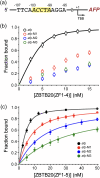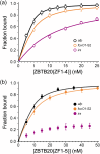Regulation of carcinogenesis through multiple zinc fingers in ZBTB20
- PMID: 40497236
- PMCID: PMC12146892
- DOI: 10.1039/d5cb00088b
Regulation of carcinogenesis through multiple zinc fingers in ZBTB20
Abstract
Zinc finger (ZF) proteins regulate transcription by interacting with cis-acting elements for gene expression in response to stimuli within physiological systems. Bioinformatic studies have proposed that zinc finger and BTB (Broad complex, Tramtrack, Bric-à-brac) domain-containing protein 20 (ZBTB20) acts as a key regulator of crucial genes associated with carcinogenesis. However, biochemical experiments using purified proteins remain unreported. In this study, we investigated the regulatory functions of the ZF domains in ZBTB20, which has five CX2CX12HX3H-type classical ZF domains, in the inhibition and expression of downstream transcription factors, including alpha-fetoprotein (AFP) and forkhead box transcription factor O1 (FOXO1). The four ZF domains of ZBTB20, ZBTB20(ZF1-4), inhibit the expression of AFP with specificity (K d = 0.6 ± 0.04 nM) by interacting with the afp promoter (5'-ACCTA). Furthermore, ZBTB20(ZF1-4) or ZBTB20(ZF1-5) inhibited the expression of FOXO1, thereby suppressing cell cycle arrest and inducing tumorigenesis by binding to the promoter of foxO1 (5'-ACCGCCGCCTC) with affinities of 1.7 ± 0.07 and 2.1 ± 0.05 nM, respectively. The results provide the first evidence that ZBTB20 regulates gene expression through ZF domains positioned at the C-terminus through interactions with cis-acting elements to achieve specificity and selectivity. The balance of ZBTB20 expression can be a crucial issue for the regulation of two downstream transcription factors to maintain homeostasis.
This journal is © The Royal Society of Chemistry.
Conflict of interest statement
The authors declare that they do not have any conflicts of interest.
Figures





References
-
- Krizek B. A. Amann B. T. Kilfoil V. J. Merkle D. L. Berg J. M. J. Am. Chem. Soc. 1991;113:4518–4523. doi: 10.1021/ja00012a021. - DOI
LinkOut - more resources
Full Text Sources
Research Materials
Miscellaneous

